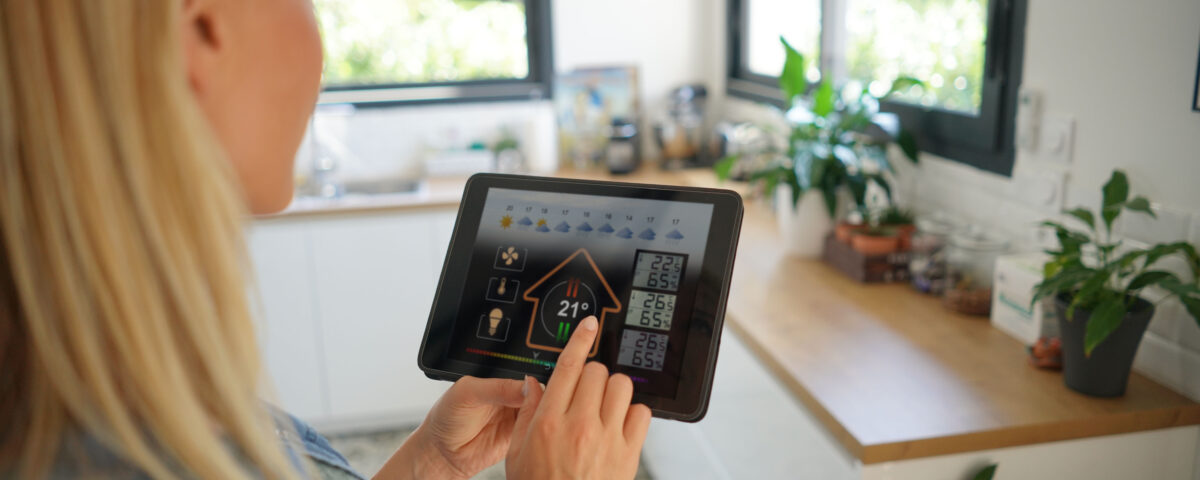
What is bringing down the cost of an electric car in 2024?
17 September 2024
How you’ll benefit from an EV solar-ready charger
20 September 2024How to use a HEMS to charge your EV for less
Winter’s rolling in. If you’re like most of us, the thought of skyrocketing energy bills probably sends a chill down your spine, even before the temperature drops.
You might already be looking for better energy tariffs–Jumping from one app to another trying to manage your home devices and optimise EV charging. Or maybe you’ve already given up — it’s all too complicated; You’ll just have to take the hit somehow…
What if we told you there was a way to get better results — without all the hassle?
It’s called a Home Energy Management System (HEMS). In this guide, we’ll explain exactly what it is. We’ll also show you how it can help you take control of your energy usage, and cut carbon emissions and expenses.
HEMS and the art of slashing your energy bills
A HEMS is a smart blend of software and hardware that serves as the control centre for all your home energy needs.
The hardware consists of electricity meters and sensors, and wired or wireless connections to your appliances. This includes your EV charger and (if you have them) solar panels and batteries.
The software communicates with the hardware to gather and analyse data, set preferences and schedules, and monitor and optimise how and when your appliances consume electricity.
To do this, it looks at your energy consumption patterns, electricity prices, weather, and a list of other data points to determine the most efficient and cost-effective way to use energy in your home.
It doesn’t do this randomly either. The HEMS goal is to ensure that every kWh consumed is worth its penny.
The system analyses a vast amount of data to:
- Find the cheapest and greenest times to charge your EV and other devices
- Find the most cost-effective tariffs
- Detect inefficiencies in your energy usage and consumption
- Decide when to use the electricity generated by your solar panels vs. from the grid
- Provide recommendations on how to reach your goals faster
- Track and reflect your progress
The data HEMS looks at
- Energy consumption: Similar to a fitness tracker that shows how many steps you’ve walked, a HEMS will monitor your historical and real-time energy consumption. This means you can keep track of which appliances are on and off, which ones consume the most energy, and which might be malfunctioning and using more energy than they should.
- Energy tariffs and peak usage periods: Keeping track of when best to switch on an appliance is exhausting. A HEMS takes this strain away from you. It will look at your energy tariff and usage data to determine when to increase or decrease the use of electricity. This enables you to minimise your energy costs and carbon footprint.
- Weather forecasts: An effective energy management will take into account weather patterns to determine when best to schedule appliances to run. This is particularly useful if you have solar panels and generate your own electricity or when you want to ensure you are only consuming green electricity from the grid.
- Energy sources available: Using solar thermal, wind, or solar panels? Excellent. But how do you know how much of it you’ve got, when to use the energy produced, when to store it, and when to send “leftovers” back to the grid? This is only possible by looking at the full picture, including energy prices, the weather forecast, and your usage patterns to make a well-calculated decision.
Understanding your EV’s energy needs
Every EV has specific energy needs. These needs are influenced by:
- Energy sources (battery vs hybrid vs plug-in hybrid)
- Range (How far it can travel with a full battery)
- Battery capacity (The maximum charging speed compatible with your EV)
- Charging speed available (slow vs fast vs rapid vs ultra rapid)
For example, standard chargepoints put out between 3.5kW and 7kW of power. That means you’ll need between four to eight hours to fully charge your EV (the exact time depends on the size of your battery). You can usually count on a 10-25 mile top-up per hour of charging.
Once you know how much energy your EV needs, you can tell your HEMS when to charge it up. Or, in the case of a top-level HEMS, it will be able to determine that on its own.
How the extended family of appliances fits in
We probably wouldn’t be too far from the truth by saying that your EV isn’t the only thing using up your home’s energy. There are the occasional energy guzzlers — an oven, a dishwasher, a tumble drier, a washing machine, and a merry crowd of always-on appliances — your fridge, your freezer, broadband router, and so on.
If you really want to cut down your energy costs, you’ll need to consider the role of this extended family of appliances in your energy consumption. For example:
- What’s the average electricity consumption in 24 hours?
- How big a difference does the dishwasher and the washing machine make when they join the table?
- What are your options for limiting the negative effects on your budget?
This is where a HEMS makes a lot of difference. The system not only takes care of data gathering and calculations for them but also makes sure everyone in the family gets their share without breaking the bank.
How to spot a good HEMS
The non-negotiables
There are a few non-negotiables that should come with any Home Energy Management System you choose.
- Device compatibility: For any of this to work, your HEMS needs to be able to talk to all the appliances in your home, not just a select few. It needs the capability to monitor, control, as well as optimise all the devices in harmony. Otherwise, it’s like getting a sports car but never taking it further than driving around the block.
- Real-time monitoring: Imagine being at a football match and the scoreboard is 20 minutes behind. Unthinkable, right? Your HEMS should offer a detailed, real-time overview of how much energy you’re consuming, when, and how — any time you need it.
- User-friendly interface: Look at the web and mobile platforms the HEMS comes with. Are they easy to navigate? Are all the data insights you’re looking for there? There’s no point in gathering data if you can’t find, manage, or understand it without taking a course.
- Good level of control: The idea of the HEMS is to increase energy- and cost-efficiency with less time investment on your part. However, it should still allow you to connect and control its settings. That includes manually turning appliances on and off, adjusting timers, changing your EV’s charging schedule, and so on — from any device.
- Integration with renewable energy sources: Even if you don’t have solar panels today, you may choose to install them tomorrow. Your existing HEMS (and EV charging setup) shouldn’t stand in the way — or cause you to double the investment because all of it needs to be changed and reinstalled. There are HEMS solutions that are compatible with renewable energy sources out of the box.
- AI-powered analytics: With so much data on your hands, AI is no longer a luxury. It’s a necessity. There are HEMS that can connect to your EV’s charger and understand your specific circumstances, needs, and goals (financial as well as environmental). Without AI, you’re just looking at a bunch of nice charts and data points without exploring all the opportunities they present (or spending hours on manual data gathering and calculations to do so).
The “highly recommended”
While you can get a very decent deal with the features described above, there’s one more thing that can really take your cost-efficiency to the next level — an AI-powered personal energy management assistant.
Imagine not just looking at data insights but having someone to:
- Deliver personalised recommendations for higher energy efficiency
- Choose the best tariffs and the cheapest EV charging times for you
- Compare and advise on the best solar power solutions for you
- Ensure you’re making the greenest energy choices, based on your personal goals
- Automate energy management for you, while allowing you to make adjustments and exceptions when needed
- Know when it’s more cost-efficient to store the solar power generated for later use (vs sending it back to the grid) — and act accordingly without requiring your interference
(Hint: That’s what it’s like when you’ve got Powerverse Raya on your side.)
Whichever HEMS you decide to go with, we do recommend that you have one. It will save you hours of research and calculations, non-stop jumping between apps of all the smart devices in your home (the EV, the EV charger, the heating system, we could go on…), and, importantly, help make sure you do get the best deals in the market.
About Powerverse
We’re industry experts in home energy management. Our easy-to-use app is built for your future electric home. It will effortlessly sync your solar, battery, heat pump, EV charger and more, helping you cut costs and your carbon footprint on your way to becoming energy-independent. Curious to know more? Talk to one of our experts.

